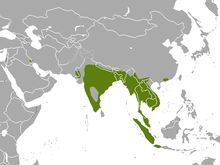Indian otter
| Indian otter | ||||||||||||
|---|---|---|---|---|---|---|---|---|---|---|---|---|

Indian river otter ( Lutrogale perspicillata ) on the banks of Tungabhadra |
||||||||||||
| Systematics | ||||||||||||
|
||||||||||||
| Scientific name of the genus | ||||||||||||
| Lutrogale | ||||||||||||
| JE Gray , 1865 | ||||||||||||
| Scientific name of the species | ||||||||||||
| Lutrogale perspicillata | ||||||||||||
| ( I. Geoffroy Saint-Hilaire , 1826) |
The Indian otter ( Lutrogale perspicillata ), and smooth otters or soft coated otter called, is one in South and Southeast Asia living carnivore species of the subfamily of the Otter (Lutrinae) within the family of Marten (Mustelidae).
features
Indian otters are similar to the Eurasian otters , but differ in their softer, silky fur , flatter tail, rounder skull with a shorter snout and larger teeth. Like all otters, they have an elongated, cylindrical body with short legs. Their fur is gray-brown on top, the underside is lighter. The cheeks, throat, and chest are whitish. These animals reach a head body length of 65 to 79 centimeters, a tail length of 40 to 51 centimeters and a weight of 7 to 11 kilograms, so they are almost the same size as the Eurasian otter.
distribution and habitat
The distribution area of the Indian river otters extends from Pakistan and India across Southeast Asia to the islands of Borneo and Java , an isolated population lives in southern Iraq . Their habitat are lakes, rivers and other bodies of water in forests, mangrove areas, swamps and even rice fields. Although predominantly water-bound, they also cover longer distances on dry land, especially in the dry season.
Way of life
These animals live in family groups consisting of a male, a female and their offspring. As resting places, they use self-dug structures that they build in the bank area. One group lives in an area that extends approximately 7 to 12 kilometers along a body of water.
food
Fish make up the largest part of the diet of these animals, they often hunt in families and so drive the fish together in order to be able to catch them more easily. They also eat insects , frogs and crustaceans .
Reproduction
The gestation of the Indian otter is around 60 days by a dormancy , the gestation period but may be longer. The two to five young animals are raised in a plant-padded earth building, after around 130 days they are weaned. Both parents take care of the offspring and provide them with food before they become independent when they are around one year old. Life expectancy in the wild is around four to ten years, in human care up to 20 years.
Subspecies
There are three subspecies:
- Lutrogale perspicillata perspicillata ( Geoffroy Saint-Hilaire , 1826), distributed from India through Southeast Asia to Indonesia
- Lutrogale perspicillata sindica ( Pocock , 1940), in Pakistan (Synonym Lutrogale perspicillata maxwelli )
The Iraqi population of the Pakistani otter Lutrogale perspicillata sindica , previously regarded as an independent subspecies Lutrogale perspicillata maxwelli ( Hayman , 1957), was last recorded in the 1960s and is now believed to be extinct due to the drainage of the swamps. The friendship between the Iraqi otter Mijbil and the Scottish writer Gavin Maxwell, which served as a template for the film My Friend, the Otter ( Ring of Bright Water ), became world famous .
Use as a hunting animal
In the Sundarbans , otters are used by fishermen as hunting aids. The otters are let into the water on lines, where they drive the fish into the nets. They are also used as bait for hunting ganges dolphins .
Danger
The habitat of the Indian river otters is becoming more and more restricted by deforestation, river damming and water pollution. In some regions they have already become rare or become extinct, overall the species is listed as endangered ( vulnerable ) by the IUCN . Little is known about the status of the isolated population in southern Iraq, since their area of distribution was the scene of armed conflicts and the swamp areas there are being drained more and more, so it is likely to be threatened too.
Surname
The generic name Lutrogale is a combination of lutra ("otter") and gale ("weasel"). The species name perspicillata means "conspicuous".
literature
- Ronald M. Nowak: Walker's Mammals of the World. 2 volumes. 6th edition. Johns Hopkins University Press, Baltimore MD et al. 1999, ISBN 0-8018-5789-9 .
- Yeen Ten Hwang, Serge Larivière: Lutrogale perspicillata . Mammalian Species No. 786, 2005.
Web links
- Lutrogale perspicillata inthe IUCN Red List of Threatened Species 2010.4. Posted by: Hussain, SA, de Silva, PK & Mostafa Feeroz, M., 2008. Retrieved May 2, 2011 ..
Individual evidence
- ↑ www.Zootierliste.de. Retrieved January 15, 2018 .

